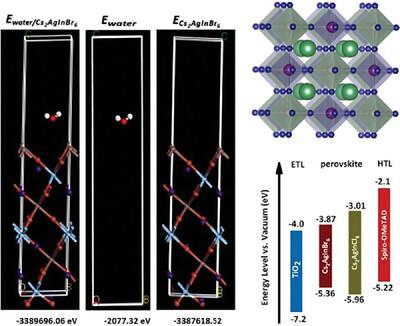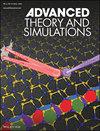无铅杂化双钙钛矿Cs2AgInX6 (X = Br, Cl)在太阳能电池中的水分子吸附、稳定性和光电特性:DFT分析
IF 2.9
4区 工程技术
Q1 MULTIDISCIPLINARY SCIENCES
引用次数: 0
摘要
卤化物双钙钛矿由于解决了铅基钙钛矿稳定性差和毒性大的问题,阻碍了钙钛矿太阳能电池的商业化,受到了许多研究者的关注。因此,本文采用密度泛函理论(DFT)计算方法研究了双钙钛矿Cs2AgInX6 (X = Br, Cl)对水分子的吸附、稳定性、光学和电子性质。理论分析表明,这些双钙钛矿具有热稳定性。均方位移分析表明,水在Cs2AgInBr6和Cs2AgInCl6层中的扩散系数远低于MAPbI3,并且根据吸附能的值,所提出的结构的亲水性低于PbI2端和MAI端表面。这些材料比相应的三维钙钛矿具有更好的延展性和机械稳定性。对于Cs2AgInBr6和Cs2AgInCl6,利用Perdew - Berke - Ernzerhof +自旋-轨道耦合(PBE0+SOC)杂化功能,直接带隙值分别为1.49和3.14 eV。对关键太阳能电池参数的计算预测,Cs2AgInBr6由于其高短路电流,可能达到与MAPbI3竞争的效率,使其成为一种有前途的稳定、无毒的钙钛矿吸收材料。这项工作提供了基本的见解,可以指导进一步研究双钙钛矿无铅,耐湿钙钛矿太阳能技术。本文章由计算机程序翻译,如有差异,请以英文原文为准。

Water Molecules Adsorption, Stability, and Optoelectronic Characteristics of Pb‐Free Hybrid Double Perovskites Cs2AgInX6 (X = Br, Cl) for Solar Cells Application: A DFT Analysis
The development of halide double perovskites has received a lot of interest from many researchers due to solving the problem of poor stability and toxicity of lead‐based perovskites, which hinders the commercialization of perovskite solar cells. Therefore, in this work, the adsorption of water molecules, stability, optical, and electronic properties of double perovskites Cs2 AgInX6 (X = Br, Cl) are investigated using Density Functional Theory (DFT) calculations. Theoretical analysis shows that these double perovskites are thermodynamically stable. The diffusion coefficient of water in layers of Cs2 AgInBr6 and Cs2 AgInCl6 is much lower than that of MAPbI3 according to means square displacement analysis, and also based on values of adsorption energy, the hydrophilicity of the proposed structure is lower than that of PbI2 ‐terminated and MAI‐terminated surfaces. These materials demonstrate better ductility and mechanical stability than their corresponding 3D perovskites. For Cs2 AgInBr6 and Cs2 AgInCl6 , direct bandgap values are 1.49 and 3.14 eV, respectively, using hybrid Perdew‐Berke‐Ernzerhof + spin‐orbit‐coupling(PBE0+SOC) functional. Calculations of key solar cell parameters predict that Cs2 AgInBr6 may achieve efficiencies competitive with MAPbI3 due to its high short‐circuit current, making it a promising stable, non‐toxic perovskite absorber material. This work provides fundamental insights that can guide further research on double perovskites for lead‐free, moisture‐resistant perovskite solar technologies.
求助全文
通过发布文献求助,成功后即可免费获取论文全文。
去求助
来源期刊

Advanced Theory and Simulations
Multidisciplinary-Multidisciplinary
CiteScore
5.50
自引率
3.00%
发文量
221
期刊介绍:
Advanced Theory and Simulations is an interdisciplinary, international, English-language journal that publishes high-quality scientific results focusing on the development and application of theoretical methods, modeling and simulation approaches in all natural science and medicine areas, including:
materials, chemistry, condensed matter physics
engineering, energy
life science, biology, medicine
atmospheric/environmental science, climate science
planetary science, astronomy, cosmology
method development, numerical methods, statistics
 求助内容:
求助内容: 应助结果提醒方式:
应助结果提醒方式:


